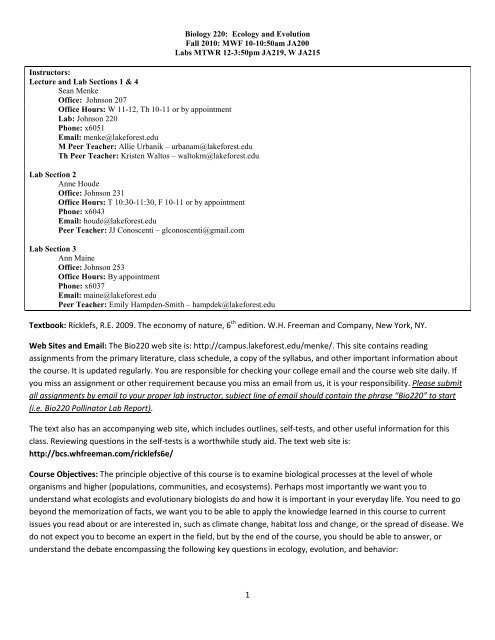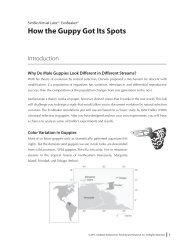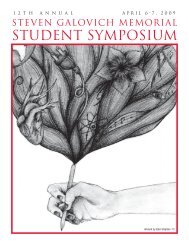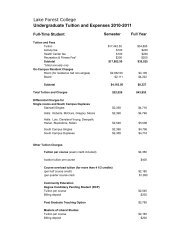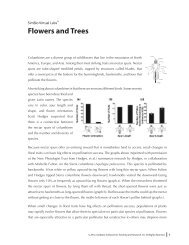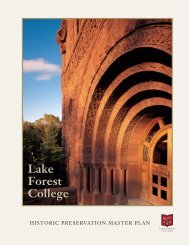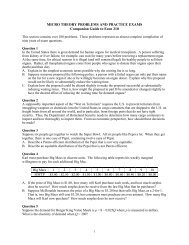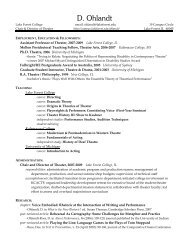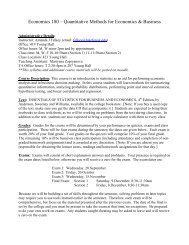1 Textbook: Ricklefs, R.E. 2009. The economy of nature, 6th edition ...
1 Textbook: Ricklefs, R.E. 2009. The economy of nature, 6th edition ...
1 Textbook: Ricklefs, R.E. 2009. The economy of nature, 6th edition ...
Create successful ePaper yourself
Turn your PDF publications into a flip-book with our unique Google optimized e-Paper software.
Biology 220: Ecology and EvolutionFall 2010: MWF 10-10:50am JA200Labs MTWR 12-3:50pm JA219, W JA215Instructors:Lecture and Lab Sections 1 & 4Sean MenkeOffice: Johnson 207Office Hours: W 11-12, Th 10-11 or by appointmentLab: Johnson 220Phone: x6051Email: menke@lakeforest.eduM Peer Teacher: Allie Urbanik – urbanam@lakeforest.eduTh Peer Teacher: Kristen Waltos – waltokm@lakeforest.eduLab Section 2Anne HoudeOffice: Johnson 231Office Hours: T 10:30-11:30, F 10-11 or by appointmentPhone: x6043Email: houde@lakeforest.eduPeer Teacher: JJ Conoscenti – glconoscenti@gmail.comLab Section 3Ann MaineOffice: Johnson 253Office Hours: By appointmentPhone: x6037Email: maine@lakeforest.eduPeer Teacher: Emily Hampden-Smith – hampdek@lakeforest.edu<strong>Textbook</strong>: <strong>Ricklefs</strong>, R.E. <strong>2009.</strong> <strong>The</strong> <strong>economy</strong> <strong>of</strong> <strong>nature</strong>, 6 th <strong>edition</strong>. W.H. Freeman and Company, New York, NY.Web Sites and Email: <strong>The</strong> Bio220 web site is: http://campus.lakeforest.edu/menke/. This site contains readingassignments from the primary literature, class schedule, a copy <strong>of</strong> the syllabus, and other important information aboutthe course. It is updated regularly. You are responsible for checking your college email and the course web site daily. Ifyou miss an assignment or other requirement because you miss an email from us, it is your responsibility. Please submitall assignments by email to your proper lab instructor, subject line <strong>of</strong> email should contain the phrase “Bio220” to start(i.e. Bio220 Pollinator Lab Report).<strong>The</strong> text also has an accompanying web site, which includes outlines, self-tests, and other useful information for thisclass. Reviewing questions in the self-tests is a worthwhile study aid. <strong>The</strong> text web site is:http://bcs.whfreeman.com/ricklefs6e/Course Objectives: <strong>The</strong> principle objective <strong>of</strong> this course is to examine biological processes at the level <strong>of</strong> wholeorganisms and higher (populations, communities, and ecosystems). Perhaps most importantly we want you tounderstand what ecologists and evolutionary biologists do and how it is important in your everyday life. You need to gobeyond the memorization <strong>of</strong> facts, we want you to be able to apply the knowledge learned in this course to currentissues you read about or are interested in, such as climate change, habitat loss and change, or the spread <strong>of</strong> disease. Wedo not expect you to become an expert in the field, but by the end <strong>of</strong> the course, you should be able to answer, orunderstand the debate encompassing the following key questions in ecology, evolution, and behavior:1
Labs:1) What is natural selection, and what are the mechanisms and consequences <strong>of</strong> evolution?2) What roles do natural ecosystems play in the maintenance <strong>of</strong> human populations? What roles do humans play inthe functioning <strong>of</strong> natural ecosystems?3) Why are some plants and animals common while others are rare?4) What limits the local, continental, and global distribution <strong>of</strong> living things?5) Why are there so many different types <strong>of</strong> living things on earth? Why are there not more?6) How do ecosystems work?We have seven lab projects scheduled over the course <strong>of</strong> the semester. You are expected to arrive at lab having read thematerials and prepared for the work that day. Many labs are outdoors and are, therefore, weather dependent. Field labsare noted by an asterisk (*) on your syllabus. Like all field biologists, we will attempt to do field work regardless <strong>of</strong> theweather, but lab projects may overlap due to weather constraints. IMPORTANT NOTE: Please dress appropriately forfield labs!!! You will be outdoors for extended periods <strong>of</strong> time and field work is VERY messy. Wear a hat, comfortableclosed-toe shoes, socks, and grungy (preferably light colored) pants and a long sleeved shirt. This clothing, while lookingsilly, will help protect you from mosquitoes, ticks, chiggers, poison ivy, and various other irritants. You are responsiblefor your own allergy meds, asthma inhalers, epi-pens, etc. if you may need them. Sunscreen and insect repellent will beprovided for all outdoor labs.Exams:<strong>The</strong>re will be two midterm exams and one comprehensive final. Each exam will be held in class and cover material fromlecture, assigned readings, and labs. On exam days please arrive as early as possible and immediately put away booksand notes and turn <strong>of</strong>f ALL electronics before exams are distributed. Only college-approved excuses will be accepted formissed exams. Please see me as soon as you are aware <strong>of</strong> a conflict for an exam. Exams must be made up within oneweek <strong>of</strong> the original exam date. Makeup exams will be composed <strong>of</strong> essay questions only.Weekly Quiz:<strong>The</strong>re will be 12 quizzes scattered in class throughout the semester. Your lowest quiz score will be dropped. Quizzescannot be made up if you are absent. Quizzes will be primarily based material covered in class, on your lab groups bookreview and on material in the NY Times Scientific Blog: http://scientistatwork.blogs.nytimes.com/.Journal Club (20 points each):For each <strong>of</strong> the three multi-week lab projects, lab groups will present and discuss primary research articles on the topic.Your lab handout will include a list <strong>of</strong> literature references for these articles, and they will be available on the courseweb page as pdfs. <strong>The</strong>se articles will also be used when writing lab reports. Each lab group will present one <strong>of</strong> thearticles (chosen in the previous lab) to the class. Journal club presentations will take place in lab. All individuals in thegroup must participate in each journal club presentation. Each presentation should last 5-7 minutes and should include apower point slide <strong>of</strong> the most important figure or table from the paper. Because these presentations are to be useful toyour fellow students, students will be encouraged to ask questions!Each presentation should follow this basic outline (Again, highlighting the most important result):2
I. Introductiona. Who wrote the paper and where are they from? What is the title <strong>of</strong> the paper?b. What organisms were used in the study and where and when did the study take place?c. What were the null and alternative hypotheses? Each should be clearly defined and discussed in thepresentation.II. Methodsa. Briefly outline the materials and methods for the class so they know what was done.b. Briefly mention the statistics used to analyze the data.III. Resultsa. Explain the main results <strong>of</strong> the study using the figures in the paper.b. Check paper for any important results not summarized in a figure or table.c. You don’t need to present every single result, just the highlights.IV. Discussion (It is important not to forget this!)a. Discuss why the study was important in the field.b. Outline possibilities for future research.Lab Reports (40 points each):A total <strong>of</strong> four brief lab reports (on the field labs) will be team written by your lab group. (Lab reports are to be amaximum <strong>of</strong> 5 pages <strong>of</strong> text (double spaced, one inch margins, 12 point - times new roman font), plus tables and figures.Lab reports are due one week after the lab has been completed. See the course web page for suggestions on how towrite a lab report. Lab reports must include citations from at least three <strong>of</strong> the primary literature papers provided for theclass. Because this is a team project, all members must help write the report. We will grade each report and everymember <strong>of</strong> the group will receive 80% <strong>of</strong> that score, the remaining 20% <strong>of</strong> the points (per group member) will be dividedamong the group members, by the group members, based on their participation in that lab. So each group member willemail their pr<strong>of</strong>essor the % participation <strong>of</strong> each lab member in their group for that project, we will average thosescores, and then assign the remaining points.Symposium (60 points):Each lab group will select one lab exercise (Pollination, Biological Diversity, and Foraging) and expand their write-up intoa 20 minute scientific presentation (Week <strong>of</strong> 28 November 2011). <strong>The</strong>se presentations will be given in a scientificsymposium session with time allowed for questions by the audience.Book Review (60 points):1) Dr. Tatiana’s Sex Advice to All Creation: <strong>The</strong> Definitive Guide to the Evolutionary Biology <strong>of</strong> Sex by Olivia Judson2) Here Be Dragons: How the Study <strong>of</strong> Animal and Plant Distributions Revolutionized Our Views <strong>of</strong> Life and Earth byDennis McCarthy3) <strong>The</strong> Balance <strong>of</strong> Nature: Ecology’s Enduring Myth by John Kricher4) Remarkable Creatures: Epic Adventures in the Search for the Origin <strong>of</strong> Species by Sean Carroll5) <strong>The</strong> Wild Life <strong>of</strong> Our Bodies: Predators, Parasites, and Partners That Shape Who We Are Today by Rob DunnEach lab group will read one <strong>of</strong> the suggested science books during the semester and then each individual will write abook review in the style found in the journal Ecology, a monthly publication by the Ecological Society <strong>of</strong> America. <strong>The</strong>sereviews will then be submitted the student journal Eukaryon. An outline <strong>of</strong> the review will be due on the week <strong>of</strong> 31October 2011. <strong>The</strong> final version will be due on the last lab.3
Attendance Policy:You are required to attend all lectures. Out <strong>of</strong> respect for me and your fellow students, turn <strong>of</strong>f all electric devices (cellphones, pda’s, Droid, Ipad, Iphone, Itouch, etc.). Laptops are not permitted in class unless you sign a contract with me onhow your computer will be used in class.You are expected to attend all labs. Only <strong>of</strong>ficial College excused absences will be allowed, please see your lab instructoras soon as you know there will be a conflict! Because all <strong>of</strong> the lab sections are based on group projects, you will not bepermitted to attend a different lab section.Late Assignment Policy:Assignments turned in late will have 15% <strong>of</strong> their total available points deducted for each day they are late. If it is due inlab or class and you turn it in the same day, but after lab or class, it will be a 5% deduction in points. We work ourhardest to return all your assignments to you in a timely manner, which is much easier when you turn your assignmentsinto us on time.Grading: Points (1026) Your ScoreClass componentLecture Grade (606 points)Lecture Exams (2 @ 135 each) 270Final Exam 270Quizzes (11 at 6 each) 66Lab Grade (420 points)Grading:Journal Club (3 @ 20 each) 60Lab Reports (4 @ 40 each) 160Lab Handouts (4 @ 15 each) 60Symposium 60Book Review 60Class Participation / Weekly Reading 20You are guaranteed an A level grade if you have ≥ 90%, a B level grade if you have ≥ 80%, a C level grade if you have ≥70%, a D level grade if you have ≥ 60%. I encourage you to keep track <strong>of</strong> your scores in the space above so that you knowhow you are doing in the class. Please notice that lab is more than 40% <strong>of</strong> your overall grade and should be treatedaccordingly.4
Academic Integrity:You are responsible for being familiar with rules and policies concerning plagiarism and academic honesty(http://www.lakeforest.edu/academics/resources/writingcenter/honesty.php). In particular, you should not “borrow”text and phrasing from papers, websites, or other students. <strong>The</strong> work you turn in needs to be the sole product <strong>of</strong> youreffort, unless specifically instructed otherwise. Academic misconduct [defined as 1) all forms <strong>of</strong> cheating wherevercommitted, including, but not limited to, plagiarism, giving or receiving aid on an exam or quiz, copying anotherstudent’s exam, term paper, report, problem, or laboratory report, 2) theft <strong>of</strong> examinations and / or exam answers, etc.,and 3) receipt <strong>of</strong> stolen exams or exam answers, etc.] will result in an automatic zero on the assignment, and in a reportto the academic honesty judicial board. Please see your student handbook for a further discussion <strong>of</strong> this topic.Policy on Disabilities:If you have a disability, please notify us at the beginning <strong>of</strong> the semester and provide us with documentation from LFCStudent Services. We will make every effort to accommodate your needs!5
Date Topic Reading Lab26 Aug (F) Introduction --- ---29 Aug (M) Evolution introduction Ch. 6 Evobeaker (Guppies)31 Aug (W) Life history patterns Ch. 72 Sep (F) Sex, behavior, and evolution Ch. 85 Sep (M) Social behavior and evolution Ch. 9 Pollination I*7 Sep (W) Phylogeny and speciation Ch. 219 Sep (F) Human evolution12 Sep (M) Guest speakers Ch. 1 Pollination II*14 Sep (W) Ecology introduction Ch. 2-316 Sep (F) Adapting to the physical environment Ch. 4-519 Sep (M) Limits to plant and animal distributions Ch. 5 Evobeaker (Phylogeny)21 Sep (W) Biomes23 Sep (F) Species distributions Ch. 1026 Sep (M) Midterm 1 Review Biodiversity I*28 Sep (W) Exam30 Sep (F) Population size and growth Ch. 113 Oct (M) Population demography (humans and turtles) Ch. 11 Biodiversity II*5 Oct (W) Population regulation and dynamics Ch. 127 Oct (F) Maximum sustainable yield in fisheries Ch. 26, p.502-50410 Oct (M) Genetics and small populations Ch. 13 Foraging I*12 Oct (W) Extinction and conservation Ch. 12, p.260-262; Ch. 26, p.553-567; Ch. 27, 570-57914 Oct (F) Species interactions Ch. 1417 Oct (M) Mid-semester break NO LAB19 Oct (W) Disease Ch. 14, p.292-294; Ch. 15, p.315-31721 Oct (F) Predator - prey dynamics Ch. 1524 Oct (M) Competition Ch. 16 Foraging II*26 Oct (W) Competition and foraging theory Ch. 1628 Oct (F) Mutualism and coevolution Ch. 1731 Oct (M) Midterm 2 Review Book review outlines and citations due to lab instructor Foraging III*2 Nov (W) Exam4 Nov (F) Species distribution modeling6
7 Nov (M) Community structure Ch. 18 Human Demography*9 Nov (W) Succession and disturbance Ch. 1911 Nov (F) Biodiversity Ch. 2014 Nov (M) Habitat loss and biodiversity Ch. 20 GIS I16 Nov (W) Invasive species18 Nov (F) Landscape ecology Ch. 2521 Nov (M) Ecosystems, production, decomposition Ch. 22, 24 NO LAB23 Nov (W) Biodiversity and ecosystem function Ch. 26, p.545-55325 Nov (F) Thanksgiving break28 Nov (M) Nitrogen cycle and impacts <strong>of</strong> pollution Ch. 23, 24; Ch. 27, 579-586 Symposium30 Nov (W) Climate change Ch. 272 Dec (F) Urban ecology5 Dec (M) Final Review9 Dec (F) Final 8:30-11:30am7


